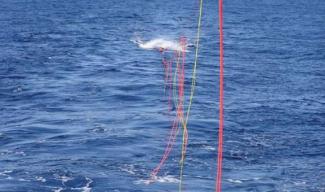Bird scaring lines, known as tori lines, are a proven method for minimising seabird bycatch while fishers are setting their longline gear. Fishers using auto-longlines must use a tori line during all line setting operations. This is a condition on fishing permits.
The problem
Fishing operations and seabird foraging zones overlap. Seabirds are attracted to fishing boats as they recognise them as a source of food.
Seabirds can get caught during both setting and hauling.
- During line setting – seabirds may attack baits on the surface or underwater to about 10 metres and become hooked or ensnared in the fishing gear and drown.
- During line hauling – seabirds may attack leftover baits as the catch is brought on board. Birds may become hooked or entangled, and injured or killed.
The solution
Fishers can minimise seabird bycatch when setting auto-longline gear by using AFMA approved tori lines. Tori lines form a physical and visual barrier around the area where line setting occurs that prevents seabirds from accessing baited hooks.
Tori lines have been shown to significantly reduce seabird bycatch during setting operations. Mitigation is most effective when used in combination with other measures including line weighting to ensure that the hooks sink more quickly, and setting at night when seabirds are less active.
Download a copy of the Using tori lines fact sheet (PDF, 501 KB) for more information.
How tori lines work
Tori lines deter seabirds from flying, swimming or diving into the setting area behind a fishing vessel. Tori lines consist of a line with streamers and a buoy or extra fishing line attached at the end to create drag. The tori line is towed from a high point near the stern of the vessel over the area where the baited hooks are deployed.
Tori lines are mandatory for fishers operating in the Eastern Tuna and Billfish Fishery, Western Tuna and Billfish Fishery, the auto-longline sector of the SESSF and Antarctic longline fisheries.
Deployed tori line

Seabird Threat Abatement Plan
The incidental catch (or bycatch) of seabirds during longline fishing operations is listed as a key threatening process under the Environment Protection and Biodiversity Conservation Act 1999. AFMA has applied a Seabird Threat Abatement Plan (TAP) for this fishing method since 1998. Under the TAP, seabird bycatch in the auto-longline hook fishing sector needs to be less than 0.01 birds per 1000 hooks in each season.